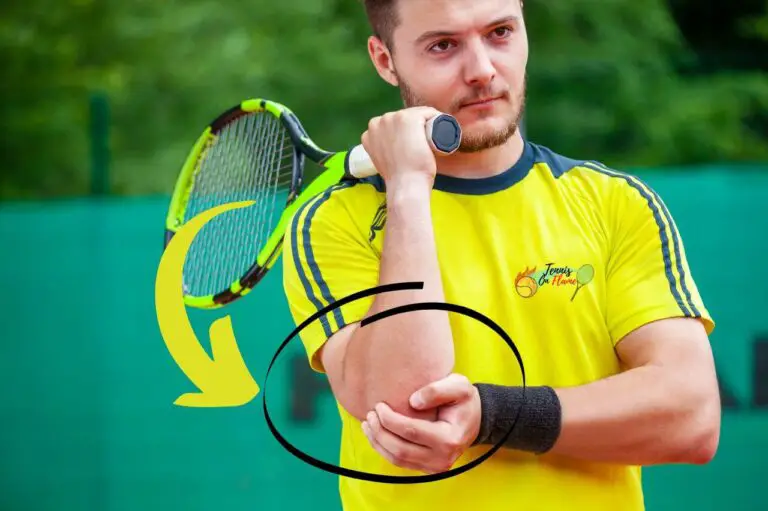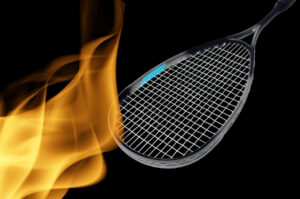Do you love playing tennis but hate the way your hand feels after and wonder “why does my hand hurt after playing with a tennis racket”? If so, you’re not alone!
Many people experience pain in their hands after playing tennis.
In this comprehensive guide, we will explore the causes of hand pain and offer some solutions to help alleviate the discomfort.
We’ll also discuss how to protect your hands from future injury.
So whether you’re a beginner or an experienced player, read on for helpful tips on keeping your hands healthy while enjoying a game of tennis!
What are the causes of hand pain include?
There are several causes of hand pain during a tennis racket game:
-Carpal tunnel syndrome: This is a condition caused by pressure on the median nerve, which can cause pain and numbness in the hands.
-Arthritis: Osteoarthritis is a type of arthritis that affects the joints, and it can cause pain and inflammation in the hands.
-Tendinitis: Tendinitis is an inflammation of the tendon, which can lead to pain and discomfort in the hands.
-A strain or sprain of the ligaments: These injuries can occur when the hand is stretched beyond its normal range of motion, and they can cause pain and swelling.
-Cysts in the ganglion nerve pathway: These are small, fluid-filled sacs that can form along the path of the nerve.
They can cause pain and tingle in the hands.
-Dealing with injuries: If you already have a hand injury, playing tennis can aggravate the condition and cause pain.
-The symptoms of scleroderma can range from mild to severe.
The skin thickens, becomes fragile and hard to the touch, and eventually, cracks (fissuring), which is referred to as rigid fasciitis or hard scleroderma.
-Extreme cold, as in the case of Raynaud’s disease, has been linked to Sjogren’s syndrome.

What are some solutions to help alleviate hand pain?
There are several things that you can do to help reduce the discomfort of hand pain:
-Rest your hands: When your hands are hurting, give them a break! Don’t play tennis until the pain subsides.
-Apply ice: Applying ice to the affected area can help reduce inflammation and swelling.
-Take over-the-counter medications: Nonsteroidal anti-inflammatory drugs (NSAIDs), such as ibuprofen, can help relieve pain and inflammation.
-Wear a brace or splint: A brace or splint can help support the hand and keep it in a neutral position.
-See a doctor: If the pain persists, see your doctor for evaluation and treatment.
-To relieve the discomfort, place a hot water bottle on the sore area.
How can you protect your hands from future injury?
There are several things that you can do to protect your hands from injury while playing tennis:
-Warm-up: Be sure to warm up your hands before playing.
-Use the proper grip: Using the proper grip can help reduce stress on the hands.
-Use an appropriate racket: Using a racket that is too heavy or too light can put a strain on the muscles and joints of the hand.
-Take breaks: Don’t play for hours on end! Take breaks to give your hands a rest.
-Stretch: Stretching the muscles and tendons of the hand can help reduce the risk of injury.
-See a doctor: If you have any concerns about your hands, see your doctor for an evaluation.
By following these tips, you can enjoy playing tennis while keeping your hands healthy and pain-free!
What is the most common injury in tennis?
The most common injury in tennis is fractures, carpal tunnel syndrome, Wrist strains, and lateral epicondylitis, also known as tennis elbow.
What cost does tennis elbow?
This condition is caused by repetitive motions of the arm and wrist, and it can lead to pain and inflammation in the elbow.
Treatment for tennis elbow typically includes rest, ice, and over-the-counter medications.
In some cases, physical therapy may be recommended. Surgery is rarely needed.
What are some of the symptoms of carpal tunnel syndrome?
The most common symptoms of carpal tunnel syndrome include pain, numbness, and tingling in the hands.
The symptoms can often be alleviated by wearing a brace or splint to keep the wrist in a neutral position.
In some cases, surgery may be necessary to relieve the pressure on the nerve.
What is the best pain reliever for hand pain?
Several different types of pain relievers can be effective for hand pain:
-Paracetamol or aspirin.
-NSAIDs: As mentioned before, nonsteroidal anti-inflammatory drugs (NSAIDs), such as ibuprofen or Advil can help reduce pain and inflammation.
-Acetaminophen: This medication can help relieve pain without reducing inflammation.
-Corticosteroids: Corticosteroid injections can help reduce inflammation and pain.
-Topical analgesics: These medications, which include creams, gels, and patches, are applied to the skin and can help relieve pain.
-Opioids: Opioids are a type of medication that can be used to treat severe pain.
Which medication is best for you will depend on the severity of your pain and your individual medical history. Be sure to talk to your doctor about which option is right for you.
In conclusion:
Hand pain can be a frustrating and debilitating condition.
There are several different causes of hand pain, and the best treatment option depends on the cause.
Rest, ice, over-the-counter medications, braces or splints, and heat may help relieve the discomfort of hand pain.
Protect your hands from injury by following these tips: warm up before playing, use the proper grip, use an appropriate racket weight, take breaks, and stretch.
If the pain persists, see a doctor for evaluation and treatment.
Non-steroidal anti-inflammatory drugs (NSAIDs) are one of the most common medications used to treat hand pain.
Ibuprofen and Advil are two examples of NSAIDs.
Other options include acetaminophen, corticosteroids, topical analgesics, and opioids.
The best pain reliever for you will depend on the severity of your pain and your individual medical history.
Be sure to talk to your doctor about which option is right for you.
By following these tips, you can enjoy playing tennis while keeping your hands healthy and pain-free!
I hope you found the answer you needed for why your hand hurt after playing with a tennis racket.
If you have any further questions about hand pain and hurt after playing with a tennis racket, please don’t hesitate to ask your doctor.
Thanks for reading! 🙂








